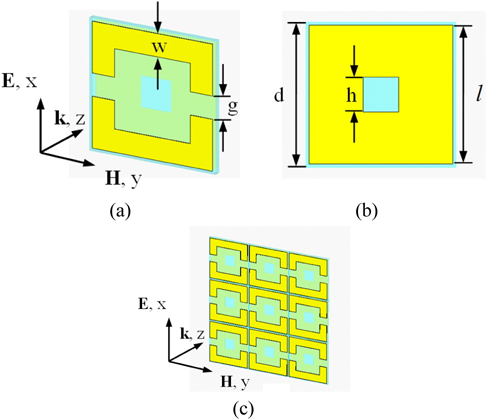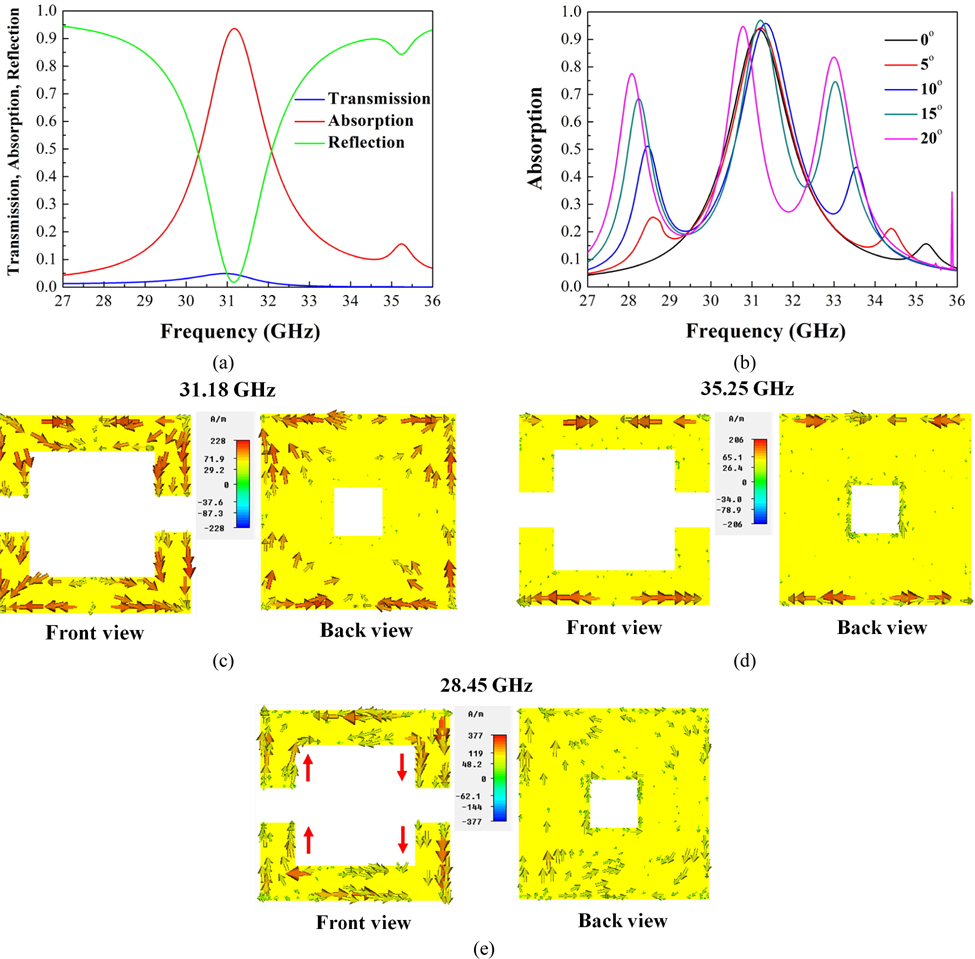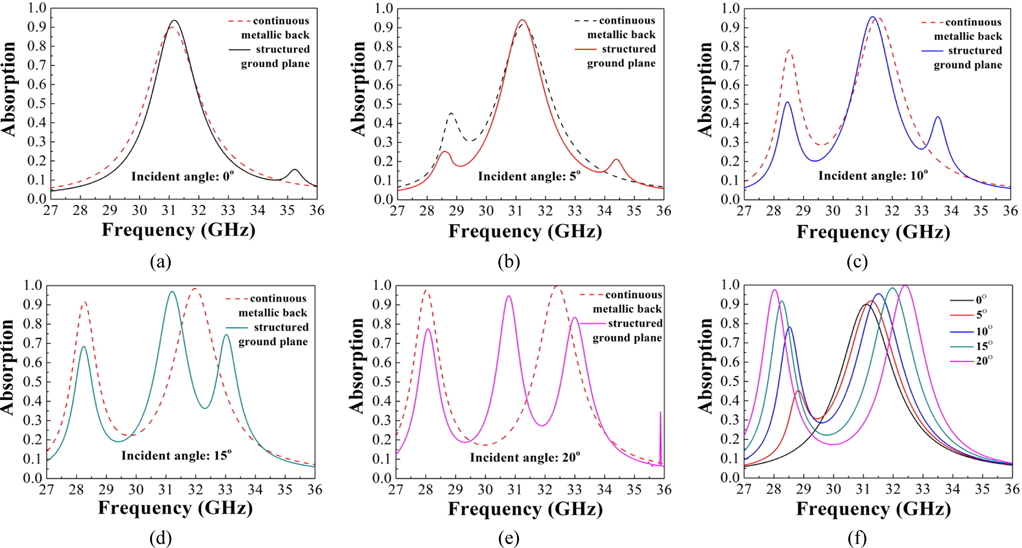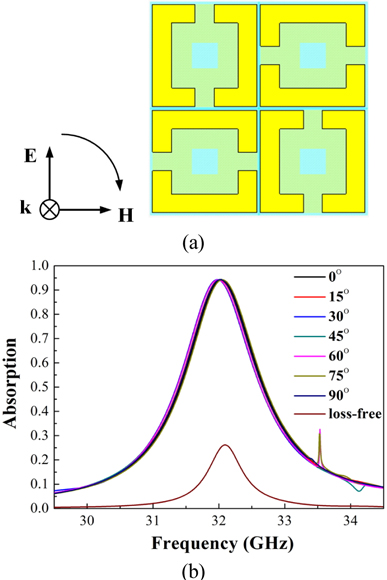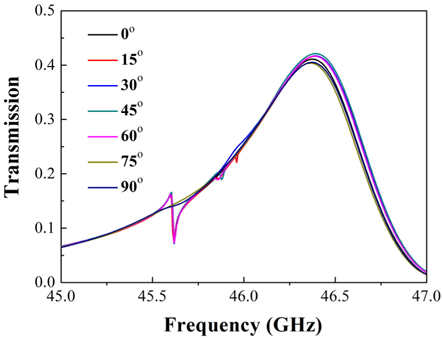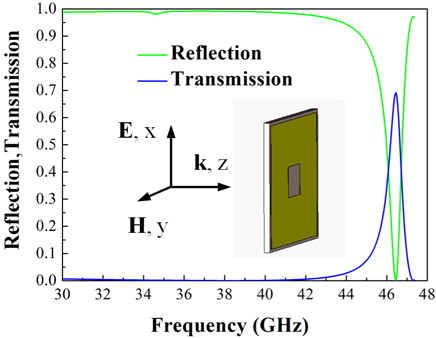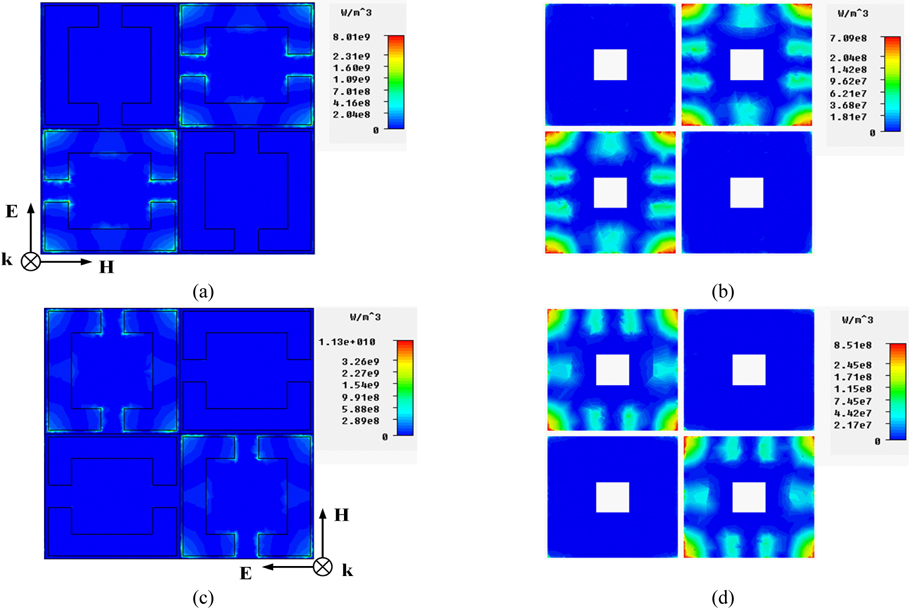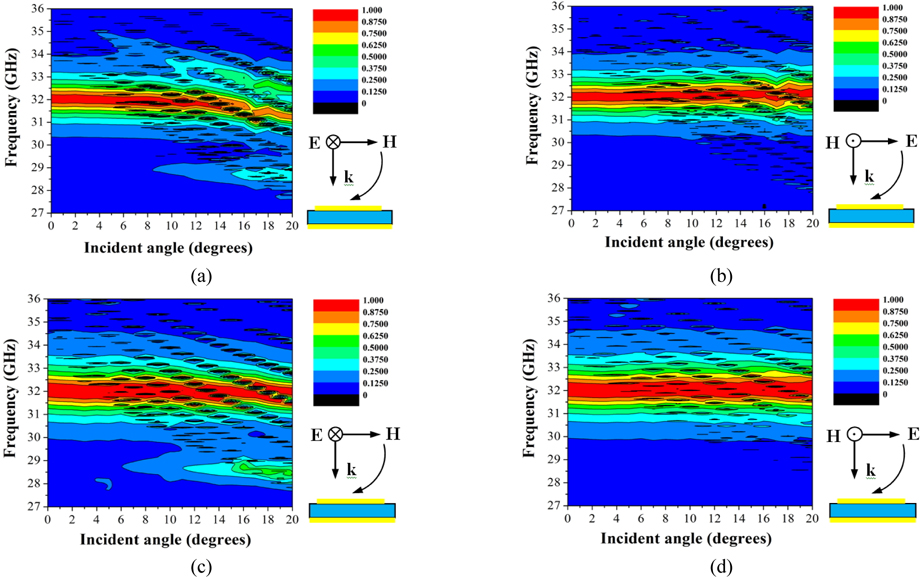



We demonstrate an ultrathin metamaterial for polarization independent perfect absorption as well as a band-pass filter (BPF) which works at a higher frequency band compared to the perfect absorption band. The planar metamaterial is comprised of three layers, symmetric split ring resonators (SSRRs) at the front and structured ground plane (SGP) at the back separated by a dielectric layer. The perfect metamaterial absorber (MA) can realize near 100% absorption due to high electromagnetic losses from the electric and/or magnetic resonances within a certain frequency band. The thickness of the structure is only 1/28 of the maximum absorption wavelength.
Metamaterials are artificial sub-wavelength materials manufactured to exhibit extraordinary electromagnetic properties such as negative refraction [1, 2], enhanced antennas [3, 4], electromagnetic cloaking [5], super-resolution [6, 7], band-pass filter [8], etc. Among the applications of metamaterials, the concept of MA has attracted considerable attention owing to its crucial importance for civilian and military applications during the last few years.
The first MA was demonstrated by Landy
The physical mechanism of the MAs can be explained with the effective medium theory. The effective material parameters include effective relative permittivity
The frequency selective surface (FSS) is a one- or two- dimensional periodic assembly of conducting patches on dielectric sheets or apertures in a thin conducting sheet which may have the property of band-stop or band-pass, respectively [31]. In our work we propose an MA design with the metallic background plane in conventional MAs replaced by a SGP which is a conducting sheet with a periodic hole array. The SGP which is actually a FSS in our design also provides the band-pass functionality in the newly designed MA.
In this paper, we first designed a polarization dependent MA based on SGP and symmetric split ring resonator (SSRR) [32]. The absorption is more than 93.7% centered at the frequency of 31.18 GHz. Then we designed a polarization independent MA through rearrangement of the SSRRs. The absorption is more than 94.3% centered at about 32 GHz, and more interestingly, a pass band with a transmission of about 42% centered at 46.40 GHz was observed from the simulation results.
II. POLARIZATION DEPENDENT PERFECT METAMATERIAL ABSORBER
In our work, a single unit cell of the polarization dependent MA consists of two distinct metallic elements (shown in Fig. 1(a)). The array of metal SSRR with two gaps is on the front layer of a dielectric substrate (blue part in Fig. 1(a)) and a metal SGP is on the back layer (shown in Fig. 1(b)).
As to the incident electromagnetic wave with electric component parallel to the split direction of the SSRR (x direction in Fig. 1(a)), the SSRR can couple strongly to it, thus supplying an independent electric response. The magnetic component of the incident wave will penetrate the front layer. Since the magnetic component is along the y direction (shown in Fig. 1(a)), it will generate anti-parallel surface currents on the SSRR and SGP along the x direction, which is the magnetic coupling and resonance. Then high electromagnetic losses from the electric and/or magnetic resonances will be introduced similar to the physical mechanism used in Ref. [9]. In order to make the wave impedance of the MA matched to that of free space, the dimensions of the SSRR should be adjusted.
We select FR-4 (lossy) with the relative dielectric constant
A numerical simulation is performed for the polarization dependent MA shown in Fig. 1(a) based on the finite element method. Periodic boundary conditions are used in the x and y directions (shown in Fig. 1(c)). For the MA, the expression of the absorption is
As shown in Fig. 2(a), the maximum absorption is about 93.7% centered at 31.18 GHz for the normal incident electromagnetic wave. When the incident angle increases from 0° to 15°, the maximum absorption frequency of the MA is centered at 31.18 GHz with almost no change (shown in Fig. 2(b)) and the maximum absorption increases from 93.7% to 96.7% with other absorption peaks created simultaneously. There is a high-frequency absorption band and a low-frequency absorption band besides the main absorption band. The main absorption band will have a red shift when the incident angle is greater than 15° (see the result when the incident angle is 20°).
To have a deep understanding of the nature of the absorption bands, the simulated surface current distributions of the three absorption bands are presented in Figs. 2(c)-(e). As shown in Fig. 2(c), the anti-parallel currents at the front SSRR and back SGP at 31.18 GHz indicate that the main absorption band for the normal incidence is induced by the magnetic resonance. From the surface current distributions (not shown here), the main absorption bands for the incident angles of 5°-20° are also induced by the magnetic resonance. The distribution of surface current at the high-frequency absorption peak (at 35.25 GHz) for the normal incidence is shown in Fig. 2(d). The strong parallel currents at the edges of the front SSRR and back SGP indicate that the high-frequency absorption bands for the normal incidence and non-normal incidence (not shown here) are induced by the electric resonance.
With the increase of the incident angle, the magnetic field will have component parallel to the direction of the z axis which will affect the distribution of the surface currents in the structure. Then another new mode of resonance will occur. The 10° incidence is taken as an example to illustrate this phenomenon shown in Fig. 2(e). The z direction component of the magnetic field generates a current circle, which is marked by the red arrows in Fig. 2(e). This new mode of low-frequency resonance with a frequency of 28.45 GHz for 10° incidence and those for other non-normal incidences (not shown here) are also magnetic resonances from the surface current distributions.
In order to find the difference between the newly designed MA and the conventional MA, the SGP used in our design is replaced by a continuous metallic back to form the conventional MA. When the incident angle increases from 0° to 20°, the absorption comparisons between the newly designed MA and the conventional MA are shown in Figs. 3(a)-(e). Our newly designed MA has almost the same absorption band and absorption intensity as the conventional MA for the normal incident electromagnetic wave. However, the maximum absorption band of the newly designed MA has little change when the incident angle is lower than 15° as mentioned above. While the maximum absorption band of the conventional MA will shift with the increase of the incident angle (shown in Fig. 3(f)).
III. POLARIZATION INDEPENDENT PERFECT METAMATERIAL ABSORBER AND BAND-PASS FILTER
A single SSRR is a polarization dependent resonant structure from the above analysis due to the nonsymmetric nature of the SSRR both in the x and y directions of the unit cell. In the following, a polarization independent absorber is constructed and analyzed. Two sets of SSRRs are employed with orthogonal orientations in the unit cell to construct a polarization independent MA shown in Fig. 4(a). The structure has the same parameters with the polarization dependent MA shown in Fig. 1.
From Fig. 4(b) we can see that the electromagnetic waves are perfectly absorbed in the same band for polarization angles ranging from 0° to 90° due to the symmetry of the designed polarization independent MA. For example, the maximum absorption is 94.3% at 32.04 GHz for the polarization angle of 0°, and the maximum absorption is 94.3% at 32.02 GHz for the polarization angle of 90°. The full width at half maximum (FWHM) of the absorption band is about 1.33 GHz. And the total thickness of the unit cell is only about 1/28 of the maximum absorption wavelength.
In Section II the maximum absorption is about 93.7% centered at 31.18 GHz in Fig. 2(a), while it reaches 94. 3% centered at 32.04 GHz in Fig. 4(b) for the normal incident electromagnetic wave with polarization angle of 0°. The shift of the absorption frequency should be caused by the change in the arrangement of the SSRRs.
As shown in Fig. 5, a transmission band centered at 46.40 GHz for the normal incident electromagnetic waves can also be found for the polarization independent MA. The maximum transmission is about 42% with a FWHM of 0.79 GHz independent of the polarization angles. To explain the band-pass features, the reflection and transmission of the SGP used in the unit cell with an FR-4 dielectric substrate of thickness 0.3 mm are calculated for the electromagnetic wave with polarization angle of 0° (shown in Fig. 6). As shown in Fig. 6, simulation shows that a wave band centered at 46.46 GHz can pass though the structure with a transmission of 69.1%, leading to the bandpass property of the polarization independent MA and BPF. As to the electromagnetic wave with frequency of 32.04 GHz, the SGP served as a complete reflector similar to the metal ground plane used in conventional MAs.
To obtain insight into the physical mechanism of the absorbing property of the polarization independent MA, the power loss density distributions at frequencies of 32.04 GHz and 32.02 GHz for polarization angles of 0° and 90° are also calculated, respectively, and the results are shown in Fig. 7. It is seen that the resonances will occur when the electric components of the incident waves are parallel to the split directions of the SSRRs.
From the simulation results shown in Fig. 7, the maximum dielectric loss density (shown in Figs. 7 (a), (c)) is an order of magnitude greater than that of the Ohmic loss (shown in Figs. 7(b), (d)) at frequencies of 32.04 and 32.02 GHz, respectively. Fig. 4(b) also shows the absorption spectra when the dielectric layer is loss-free. The maximum absorption caused by the Ohmic losses is only 26.2% which is much less compared with the value (68.1%) caused by the dielectric losses. The result is in accordance with studies of MAs where it was found that Ohmic losses were relatively insignificant compared with dielectric losses as to the metamaterial-based perfect absorbers when the thickness of the copper used in the MAs is on the order of µm [33, 34]. From Figs. 7(a), (c) we can also see that the MA concentrates the electromagnetic waves in the dielectric area covered by the SSRRs, where electromagnetic energy is converted into thermal energy, leading to the strong dielectric losses.
The newly designed polarization independent MA can also be used for non-normal incidence, in which electromagnetic waves both in the transverse-electric (TE) and transverse-magnetic (TM) modes are taken as an example. As shown in Fig. 8(a) the absorption of the TE mode is nearly independent of the incident angles below 10°. As the incident angle increases further, a red shift of the absorption band will occur. For TM mode, the absorption is nearly independent of the incident angles below 20° (shown in Fig. 8(b)). Figs. 8(c) and 8(d) show the absorption bands of the polarization independent MA when the SGP is replaced by a continuous metallic back (to construct the conventional MA). Our newly designed MA has almost the same absorption band and absorption intensity as the conventional MA for both TE and TM modes. But the absorption bands become a little narrower compared with the conventional MA. However, when the incident angle is lower than 10° there are fewer dark areas in the central absorption bands of the newly designed MA than for the conventional MA for both TE and TM modes.
In the present work, an ultrathin polarization independent MA based on SSRRs and SGP is investigated theoretically. This newly designed MA is not limited to the minimum thickness of a quarter wavelength, with a whole thickness of only 0.334 mm (about 1/28 of the maximum absorption wavelength). The proposed MA provides perfect absorption and polarization-incident angle independency in the microwave Ka frequency band (centered at about 32 GHz) while the reflection is minimized. From comparative investigations between our newly designed MA and a conventional MA, the absorption band and absorption intensity are almost the same. However, the absorption of our newly designed MA has better performance than that of the conventional MA when the incident angle is lower than 10°.
In our new design, the continuous metallic back which served as a complete reflector in conventional MAs has been replaced by a metallic SGP. Since the SGP used in the design has the property of band-pass, a transmission band centered at 46.40 GHz can be obtained. This structure can be used to prevent the electromagnetic interference in communications and provides a new way to design the MA.
